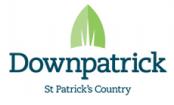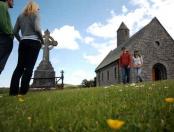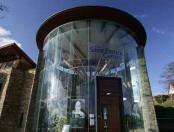Ireland - Northern Ireland
![]()
DOWNPATRICK VISITOR INFORMATION CENTRE
 Downpatrick Visitor Information Centre
Downpatrick Visitor Information Centre
53a Market Street, Downpatrick
BT30 6LZ
t: 028 4461 2233
e: downpatrick.vic@nmandd.org
w: www.saintpatrickscountry.com
St Patricks Country
This is where he began him ministry and where he died.
Walk in the footsteps of Ireland's patron saint on the St Patrick's Pilgrim Way. Visit his first church at Saul, the ancient wells at Struell and his final resting place at Down Cathedral. Discover the world's only St Patrick exhibition at Downpatrick's Saint Patrick Centre, where interactive displays and unique artifacts bring the world of easy Christian Ireland to life.
His epic story unfolded against an epic backdrop. The Mourne Mountains' granite tors erupt from the landscape and tumble into the sea. The valleys of the Ring of Gullion shelter lush forests dotted with mass stones and ancient megaliths. The drumlins of Down are capped with Norman castles and the ruins of grand abbeys. Whatever your idea of heaven, you can explore it all in Newry, Mourne and Down.



Patrick landed where the Slaney River flows into Strangford Lough (now one of the most important maritime sites in the world) in County Down. Clearly politically astute, as well as charismatic, Patrick knew the importance of making influential friends. His first conversion was Dichu, the local chieftain and brother of the High King of Ulster. In a barn donated by Dichu, Patrick preached his first sermon in Ireland. Today on this site at Saul (Sabhal, pronounced Saul, is the Irish for barn), stands a much-visited stone replica of an early church with a round tower.
Downpatrick - Saint Patrick’s Town
The later seat of the High Kings of Ulster, burial site of the patron saint and medieval capital of County Down, Downpatrick is an essential stop for those who are interested in saints, scholars and Irish Christian heritage. Spend some time at The Saint Patrick Centre, a major multimedia exhibition and learn about Patrick’s life. Visit the ancient Down Cathedral beside Saint Patrick’s Grave and then walk down the historic Georgian Mall to Down Museum which displays artefacts from Patrick’s time. Take a train ride on the only narrow gauge steam railway in Ireland through Saint Patrick’s Country with the Down Railway Museum to Inch Abbey where many of the legends of Patrick were written down in Medieval times.
You can visit the first church in Ireland at Saul and the Holy Wells at Struell with their healing waters, all within a mile of the town. Or you can climb nearby Slieve Patrick and see the largest statue of the Patron Saint in the world and trace his footsteps on Saint Patrick’s Trail to the River Slaney where he began his mission in Ireland. Whatever you choose to do you will be rewarded with this hidden world which is Saint Patrick’s town.
Down Cathedral and Saint Patrick’s Grave
Down Cathedral was built on the ancient hill of Down in the 12th Century and has become a place of pilgrimage for 1,500 years. The massive granite stone marks Saint Patrick’s Grave and it is here that people from all traditions leave wreaths on the grave every March.
Down County Museum
Situated in the Georgian County Gaol, Down County Museum holds an important collection of Early Christian objects and artefacts from Saint Patrick’s Country, including carved stone crosses. It also provides works of art, commemorative material and publications relating to the Patron Saint. Facilities include a shop, café and permanent exhibitions about the gaol and life in County Down, as well as regular temporary exhibitions. Also featured are commemorative items and sculptures of Saint Patrick showing his legacy in Down, for example, the ninth century Downpatrick High Cross is displayed in a new extension within the Museum.
Mound of Down
You can see one of the most important and dramatic early medieval Irish forts beside the River Quoile behind Down County Museum. It is the site of a motte for a timber castle, built by the Norman John De Courcy, who founded Inch Abbey on the other side of the river.
The Saint Patrick Centre
Located in Downpatrick, this is the only permanent exhibition in the world dedicated to telling the story of Saint Patrick and includes an interactive exhibition and Imax presentation. The Centre offers a cafe, art gallery, craft shop, terraced gardens and Visitor Information Centre. It is a must-see stop for travellers with an interest in Christian Ireland. Guided tours of Saint Patrick’s Country can be organised via the Centre. Admission rates are available online. www.saintpatrickcentre.com
Downpatrick and County Down Railway
This is the only full size heritage railway in Ireland, and from here you can travel by steam train to Inch Abbey, (the well preserved remains of a Cistercian monastery). You can also visit the museum to sit in the historic railway carriages, and learn more about what it was like on board a vintage railway train. The museum and steam train operate seasonally – prices and opening times are available online. www.downrail.co.uk
Inch Abbey
Having destroyed the nearby Cistercian Abbey of Erenagh in 1177 on the grounds that it was fortified against him, John de Courcy rebuilt a monastery at Inch for this order as an act of atonement in the 1180s, inviting over Cistercians from Furness in Lancashire. It became the centre of English influence in East Ulster. Attempting to impress the local populace, de Courcy commissioned one of these monks, called Jocelyn to write a life of Saint Patrick.
Saul Church
The first ecclesiastical site in Ireland was given to Patrick by the local ruler Díchu, one of his first converts when he landed at Inbher Slane (the Slaney River). The word Sabhall means barn in Irish and the site developed into a monastery which was restored by Saint Malachy around 1140. The two stone buildings beside the church, each with a stone roof, are from this period. The current Church and Round Tower were built in 1932 at the same time as the massive statue on nearby Slieve Patrick to commemorate 1500 years since Patrick’s arrival in Ireland.
Struell Wells
Among the first Holy Wells in Ireland, and blessed by Patrick when he arrived in Down, the Wells have attracted pilgrims since at least the Middle Ages. Pilgrims have wandered down the secluded valley among the wells and have taken the waters which are claimed to have healing powers. The site also contains a ruined church and ancient Bath Houses which are unique in Ireland.
For further information please contact the Downpatrick Visitor Information Centre on 028 44 61 2233
or downpatrick.vic@downdc.gov.uk.



















